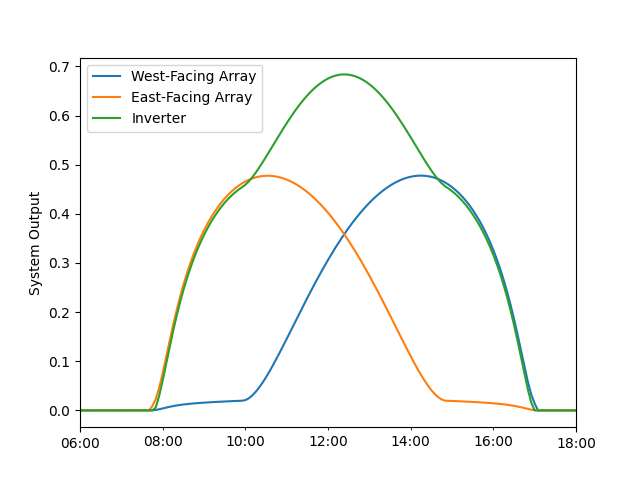Note
Click here to download the full example code
Mixed Orientation¶
Using multiple Arrays in a single PVSystem.
Residential and Commercial systems often have fixed-tilt arrays
installed at different azimuths. This can be modeled by using
multiple Array objects (one for each
orientation) with a single PVSystem object.
This particular example has one east-facing array (azimuth=90) and one west-facing array (azimuth=270), which aside from orientation are identical.
from pvlib import pvsystem, modelchain, location
import pandas as pd
import matplotlib.pyplot as plt
array_kwargs = dict(
module_parameters=dict(pdc0=1, gamma_pdc=-0.004),
temperature_model_parameters=dict(a=-3.56, b=-0.075, deltaT=3)
)
arrays = [
pvsystem.Array(pvsystem.FixedMount(30, 270), name='West-Facing Array',
**array_kwargs),
pvsystem.Array(pvsystem.FixedMount(30, 90), name='East-Facing Array',
**array_kwargs),
]
loc = location.Location(40, -80)
system = pvsystem.PVSystem(arrays=arrays, inverter_parameters=dict(pdc0=3))
mc = modelchain.ModelChain(system, loc, aoi_model='physical',
spectral_model='no_loss')
times = pd.date_range('2019-01-01 06:00', '2019-01-01 18:00', freq='5min',
tz='Etc/GMT+5')
weather = loc.get_clearsky(times)
mc.run_model(weather)
fig, ax = plt.subplots()
for array, pdc in zip(system.arrays, mc.results.dc):
pdc.plot(label=f'{array.name}')
mc.results.ac.plot(label='Inverter')
plt.ylabel('System Output')
plt.legend()
plt.show()

Total running time of the script: ( 0 minutes 0.257 seconds)